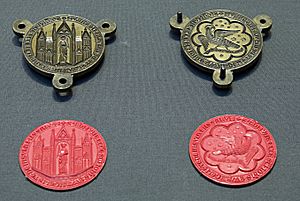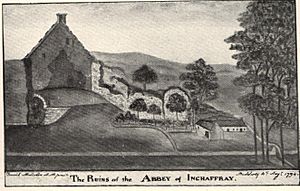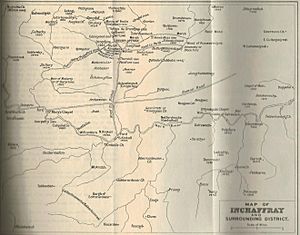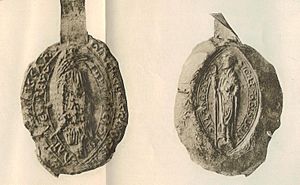Inchaffray Abbey facts for kids
Inchaffray Abbey was an important religious building in Scotland. It was located near the village of Madderty. This spot is about halfway between the cities of Perth and Crieff in an area called Strathearn.
Today, you can only see a few signs of the abbey. There's an earth mound and some old walls. These are on ground that used to be an island. This island was surrounded by marshy land, which was famous for its eels.
Contents
History of Inchaffray Abbey
The name Inchaffray has an interesting story. Some people think it comes from the Gaelic words innis abh reidh. This means "island of the smooth water."
However, the oldest records show a different name. It was called Insula missarum in Latin. This means "island of the masses" or "island of offerings." This suggests the place was important for religious services.
How the Abbey Started

Around the year 1200, a priory was built here. A priory is a smaller type of monastery. It was built by Gilbert, Earl of Strathearn and his wife, Maud d'Aubigny. They built it on a site that was already used by a group called the Culdees.
The priory was dedicated to their son, Gilchrist, who had passed away. It was also dedicated to the Virgin Mary and John the Evangelist. The priory was given to a group of monks called the Augustinians from Scone Abbey.
Inchaffray became a full abbey around 1220. This meant it was a larger and more important religious center.
Growth and Importance
Inchaffray Abbey was supported by both the Earls of Strathearn and the kings of Scotland. This helped it become very wealthy.
In 1275, a tax was taken from all religious houses. This money was used to pay for a crusade. At that time, Inchaffray Abbey earned about 246 pounds each year. This made it the fourth richest Augustinian house in Scotland. Only St Andrews, Scone, and Holyrood earned more.
Over time, the abbey owned land and churches all over Scotland. Some of its lands were as far away as Uist in the west. Others were in Balfron in the south. The monks also ordered the digging of the Pow of Inchaffray. This was a nine-mile long ditch. It was built to drain the nearby marshland and make it better for farming.
Abbots and Battles
Abbots were the leaders of the abbey. One famous abbot was Maurice of Inchaffray. He carried the holy relics of Saint Fillan to bless the Scottish army. This happened before the famous Battle of Bannockburn in 1314. The Scots won this important battle.
Another abbot, Laurence Oliphant, was also involved in a major battle. He came from a well-known family in Strathearn. Sadly, he was killed at the Battle of Flodden in 1514.
Decline and Today
By 1561, Inchaffray Abbey was not as rich as it used to be. Its income was much lower. This was also a time of big changes in Scotland, known as the Scottish Reformation. During this time, many religious buildings were changed or closed.
In 1556, Inchaffray was turned into a secular lordship. This meant it was no longer a religious abbey. Instead, it became property owned by a member of the Drummond family.
King James VI of Scotland visited James Drummond at Inchaffray in 1601. Later, the property was passed to the Earls of Kinnoull.
Much of the abbey was destroyed in 1816. This happened when a new road was built right across the site.
Today, only one gable-end wall of the abbey still stands. It is on private land but can be seen from the road. The ruins are protected as a scheduled monument.
Burials
Some important people were buried at Inchaffray Abbey:





